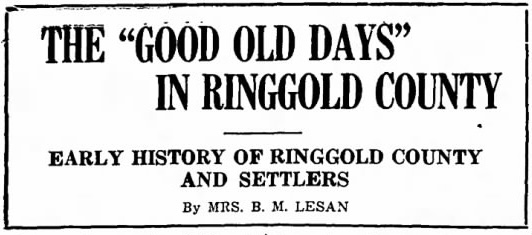 |
 
|
| |
| |
| |
| |
| |
| |
| |
| |
| |
| |
| |
| |
| |
| |
| |
| |
| |
| |
| |
This site is supported by
Friends of IAGenWeb |
 |
| site search by freefind | advanced |
The "Good Old Days"
In Ringgold County
Early History of Ringgold County and Settlers, Part 1
By Mrs. B.M. LESAN
From the Mount Ayr Record News, November 4, 1925
*Corrections to this article were printed in the follow up article November 25.
Those corrections have been applied to this transcription.The southern part of Ringgold county was involved in the famous dispute between Iowa and Missouri, which began in the autumn of 1839 and was not settled until 1850. This dispute arose in consequence of two surveys having been made of the northern boundary of Missouri. The first survey began at the head of the rapids in the Des Moines river and the second began at the foot of the Des Moines rapids in the Mississippi river. The difference between the two initial points was nearly nine miles.
Iowa-Missouri Boundary Dispute
Missouri assumed the northern line as her boundary and Iowa the southern line as hers - a conflict of jurisdiction over a strip of country nearly nine miles in width, the entire distance across the state, it being claimed by both states. After Iowa had drawn on the territorial treasurer for $1500 to defray the expense of keeping a militia to protect the rights of the people and the state, the governor of Iowa agreed with governor of Missouri for the commencement and speedy termination of a suit in the Supreme Court of the United States, to determine the true location of the boundary line between the two states. The sum of $1,000 was appropriated to defray the expenses of this suit. The vexed question was settled in Iowa's favor in 1850 when the boundary was established by commissioners appointed by the supreme court, who had the line carefully surveyed. Posts were erected, one mile apart, the entire distance between the two states, and every tenth post was an iron post, eight feet long, four inches square at one end, and eight inches square the other, to be set in ground three and one-half feet.
At the top end of the posts one side is the word, Iowa, and on the opposite side is Missouri, and on the other two sides is the word boundary, cast into the iron. The wooden posts have long since rotted out, but they served their purpose until the state line was established. One of these iron posts is in the pasture of David CAIN, who owns the land on all sides. This iron post was once along an old road near an old log cabin, where visitors and blackberry pickers went in early day to get water to drink and with which to make coffee. The dirt has washed around this post until only about two feet of the top is above ground. Some people are skeptical about these iron posts and think they are imaginary posts, like the equator.
This dispute of territory caused slavery to exist along the southern border of Iowa and several counties had trouble with the slave element after it was decided in Iowa's favor. One slave holder in Decatur county was forced to free a slave, soon after the decision and as late 1852 Littleton P. ALLEN moved from North Carolina to the southern part of Ringgold county with two slaves, a boy fourteen years old, and a girl sixteen years old. He held them as slaves for six months and sold them to a man near St. Joseph for $1100. ALLEN lived in the county thirteen years then moved to Missouri and became insane and died in an asylum.
Ringgold County's First Settlers
The first setter in Ringgold county was Chas. H. SCHOOLER in 1844. The second settler was James TETHROW (not TEDROW) in 1846. Both settled in what is now Lotts Creek township. In 1852 Littleton P. ALLEN, Jesse HARPER, Lott HOBBS and Abner SMITH settled in the southern part of the county. In 1853 This. CANEY settled west of Mount Ayr and the same year Dr. Alex McCARTNEY settled about three and one-half miles southwest of Mount Ayr. In 1854 about forty families came to the county. In 1855 about 65 more came.
County Seat Located
Twice before 1855 there had been attempts made to name and locate the county seat in the southern part of the county as most of the settlers lived there. One location was named Avon and another Urbana, but nothing came of them. In the spring of 1855 commissioners were ordered to locate and name the county seat. John S. SHELLER agreed, if they would locate the county seat on his land, he would give half the town lots to the town. The town was located on his land and named Mount Ayr on June 9, 1855 attested by Edward and Jane TEMPLE and Wm. McCORMICK was hired to do the surveying. About the 1st of June, 1855, Barton B. DUNNING, with his wife and three small sons, Walter, Frank and Day, settled in Mount Ayr and built a pole cabin and covered it with slough grass on the lot where the United Presbyterian church now stands, where they lived while he hewed logs to build a cabin. The lots in Mount Ayr were platted the latter part of June and Barton B. DUNNING built the first hewed log cabin in first Mount Ayr on the lot where the Iowa State Bank now stands. This cabin was a double log cabin with a loft in each part, the family using one part, the other used for store post office. He started this store with a trunk full of groceries he had brought with him, but soon went to Keokuk and laid in a supply of groceries; and later to St. Joseph for boots and shoes and calico and needles, pins and thread. In the summer of 1855 he was appointed postmaster and for a few months he and the boys carried the mail once per month to Pisgah, a town in Union county, twenty-four miles north and eleven miles east of Mount Ayr which had been settled a few years before and where and the first mail was carried to and from Chariton on a cow by contract to go one mile per hour. They brought back the mail for the patrons of Mount Ayr. In the fall of 1855 A.G. BEALL, David EDWARDS, Oran GORE, Chester STANDCLIFF and Dr. KEITH settled in Mount Ayr. The first organizing election was in the spring of 1855. There were thirty-four voters. James C. HAGANS was elected county judge; Joseph C. COFER, treasurer and recorder; Hiron IMUS, sheriff; Chas. H. SCHOOLER, school fund commissioner.
The First Court House
In the spring of 1856 the county judge caused the erection of hewed log court house on the lot now occupied by the Princess Theatre. It was fourteen feet square furnished with two rough tables, two desks or bookcases, and a rough box for use as a safe for money or valuable papers. It was occupied by county judge, clerk, the recorder-treasurer, surveyor and one physician as regular occupants. In the summer 1858 a young cyclone or high wind blew down this court house and the papers and money were scattered all over the county. Some was found two weeks after and some were never found. A. G. BEALL and wife and his father and mother were living in a log cabin on the lot south of where the log court house stood. The wind picked up this cabin and turned it around and set it down in the same place with the front door to the back of the house and the back door in front and the roof was carried off, but a jug of vinegar that sat on the banking around the house was not moved from its place and just enough fence in front of the house was knocked down for the house to make the turn. A. G. BEALL's father was churning for A. G.’s wife when the storm struck and the cream and half-churned butter was slung all over everything, missing nothing in the house. The rain poured in torrents on their unprotected heads but no one was injured in either the cabin or the court house. The next year, in 1859, a new frame court house was built on the east side of the square across the alley north of Simpson's store. It cost $3500 which was raised from the sale of town lots. The lumber was hauled from Burlington.
Mount Ayr's First School
The first school in Mount Ayr was a subscription school in the winter of 1855-6 taught by a Miss Brown for three months in Judge HAGAN's cabin with six or eight pupils. Then in the spring of 1856 a log school house was built on the lot where the Catholic church now stands and the district school was taught that year by Ith BEALL. Then in 1857 Charlotte SWAN taught the school. In 1858, Ith BEALL again taught the school and married the former teacher, Charlotte SWAN.
Transcription by Tony Mercer, February 11, 2025

The "Good Old Days" is a series of articles that appeared in the
Mount Ayr Record News in the 1920s about the early history of Ringgold County
Articles in this series:
Five Negroes and A Dog Funeral
Indian War of 1855
When Mount Ayr Was Wet
My Experiences of the First Two Years in Ringgold County
When Saloons Cursed Mount Ayr
How Pioneer Mount Ayr Met the Rebel Guerrillas
The Modest Styles of Long Ago
A Kidnapping Incident in Early History of Ringgold County
Early History of Ringgold County Settlers, Part 1
Early History of Ringgold County Settlers, Part 2
Thank You for stopping by!
© Copyright 1996- Ringgold Co. IAGenWeb Project All rights Reserved. |

